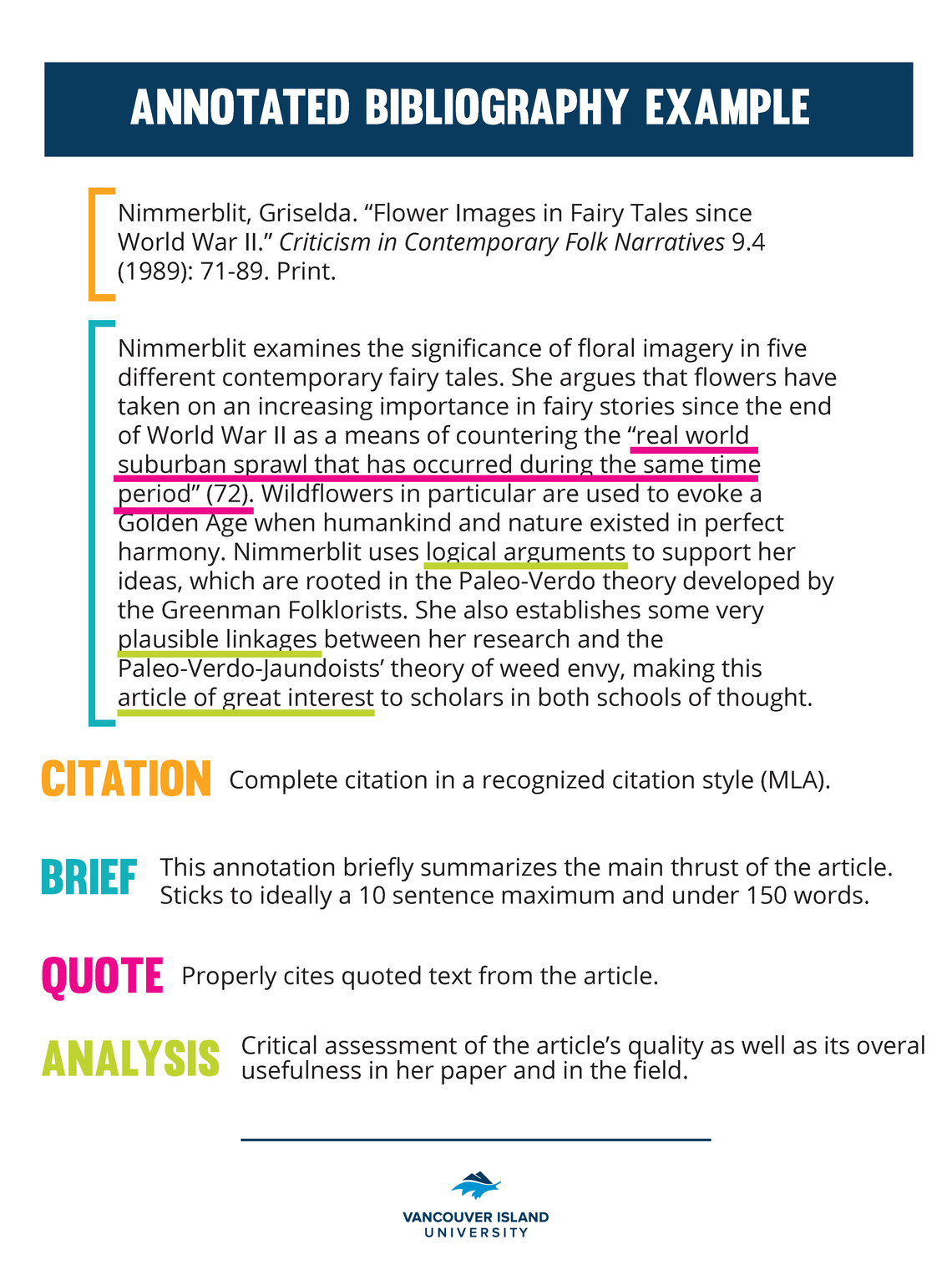

However, you could be asked to reflect on how the source relates to the themes in your research project.

Most often, this is a reflection on how useful the source is for your own research or project for instance, if you are writing the annotated bibliography in preparation for an engineering design project). In some assignments, you may be asked to include a reflection in your annotated bibliography. As with books, the presence and quality of a bibliography at the end of the article may reflect the care with which the authors have prepared their work. Reading the article abstract and scanning the table of contents of a journal or magazine issue is also useful. Read the chapters that specifically address your topic. Note whether bibliographies are included. Scan the table of contents and the index to get a broad overview of the material it covers. Read the preface to determine the author's intentions for the book.

You should examine the body of the source. The annotations should show how you're critically appraising and analyzing the sources for your bibliography, In addition to initially examine the nature of the source from the Author, Date, Edition, Publisher, and Title. Include one or more sentences that (a) evaluate the authority or background of the author, (b) comment on the intended audience, (c) compare or contrast this work with another you have cited, or (d) explain how this work helps and support your project topic.Ĭritically Appraising the Book, Article, or Document Write a concise annotation (usually 150 words) that summarizes the central theme and scope of the book or article.Cite the book, article, or document using the appropriate style (e.g.Then choose those works that provide a variety of perspectives on your topic. Briefly examine and review the actual items.
 First, locate and record citations to books, journal articles, and documents that may contain useful information and ideas on your project topic. The ProcessĬreating an annotated bibliography calls for the application of a variety of intellectual skills: concise exposition, succinct analysis, and informed library research. Annotations are descriptive and critical they may describe the author's point of view, authority, or clarity and appropriateness of expression. AbstractsĪbstracts are the purely descriptive summaries often found at the beginning of scholarly journal articles or in periodical indexes. The purpose of the annotation is to inform the reader of the relevance, accuracy, and quality of the sources cited. Each citation is followed by a brief (usually about 150 words) descriptive and evaluative paragraph, the annotation. This includes the entirety of the annotation the author’s last name is the only text that should be left aligned.The annotated bibliography is a list of citations to books, articles, and documents. Use a hanging indent so that all lines after the first line of the citation are indented. As with a standard bibliography or works cited page, an annotated bibliography should list the citations in alphabetical order and the document should be double spaced. Typically your professor will determine the length and necessary content for annotations. It may also include a statement from the individual using the source about why this source is relevant to his/her work. Style GuideĪn annotated bibliography contains two parts, a citation of the source and a short summary of the source. Annotated bibliographies serve as great preparation for research projects because you will have a better idea of what each source on your bibliography is about and how it is relevant to your work. It differs from a regular bibliography in that an annotated bibliography includes a summary or evaluation of each source. An annotated bibliography is a list of sources one has used or intends to use for a research project.
First, locate and record citations to books, journal articles, and documents that may contain useful information and ideas on your project topic. The ProcessĬreating an annotated bibliography calls for the application of a variety of intellectual skills: concise exposition, succinct analysis, and informed library research. Annotations are descriptive and critical they may describe the author's point of view, authority, or clarity and appropriateness of expression. AbstractsĪbstracts are the purely descriptive summaries often found at the beginning of scholarly journal articles or in periodical indexes. The purpose of the annotation is to inform the reader of the relevance, accuracy, and quality of the sources cited. Each citation is followed by a brief (usually about 150 words) descriptive and evaluative paragraph, the annotation. This includes the entirety of the annotation the author’s last name is the only text that should be left aligned.The annotated bibliography is a list of citations to books, articles, and documents. Use a hanging indent so that all lines after the first line of the citation are indented. As with a standard bibliography or works cited page, an annotated bibliography should list the citations in alphabetical order and the document should be double spaced. Typically your professor will determine the length and necessary content for annotations. It may also include a statement from the individual using the source about why this source is relevant to his/her work. Style GuideĪn annotated bibliography contains two parts, a citation of the source and a short summary of the source. Annotated bibliographies serve as great preparation for research projects because you will have a better idea of what each source on your bibliography is about and how it is relevant to your work. It differs from a regular bibliography in that an annotated bibliography includes a summary or evaluation of each source. An annotated bibliography is a list of sources one has used or intends to use for a research project.








 0 kommentar(er)
0 kommentar(er)
